Let’s start with the basics: what’s education, and why does it matter? We’ll focus on the different stages of education and why it’s typically cut in different phases. ✂️
Overview of the Various Education Phases
At the highest level, education can be split in two:
Formal education: the full-time “initial” education, that happens before you work. We can split it in several main steps:
Pre-kindergarten Also known as “Pre-K”. Generally optional. Roughly below age 5
Primary education Also known as “elementary school”. Roughly age 6 to 10
Secondary education Also known as “middle school” and “high school”. Roughly age 11 to 18
Post-secondary education Also known as “higher education”, “colleges”, “universities”. Roughly age 18 to 23 (and sometimes more)
Continuing education: the education that happens while you work, typically a few days to a few weeks a year. Also known as “professional training”, “lifelong learning”. Roughly age 23 to 60-65 (when people retire)
Let’s put this into a nice simple diagram:
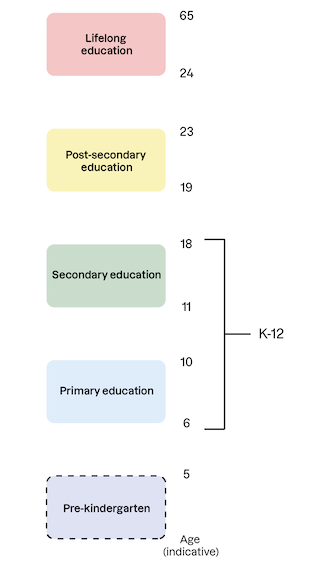
Ages are a bit simplistic, as some people can complete post-secondary later or sooner for example. However, it gives you a good sense of the main education phases.
Primary to secondary education is commonly referred as K-12 in many English-speaking countries. They are the first 12 years of education, which are generally full-time.
You’ll note that, curiously, there’s nothing for retired people after their 60s. This falsely implies that you stop learning when you retire. Also, primary to post-secondary schools are full-time experiences, while professional training is usually much more scattered: some professionals never train in a given year, or just a few days (though job seekers can train full time).
Now that we’ve taken a broad look at the main education phases, I’d like to zoom in a bit on both formal education and continuing education.
Formal Education
As I said, formal education is the first part of our education experience. We usually start by learning full-time before we start working.
There is an attempt from UNESCO to classify the different education stages, called ISCED: International Standard Classification of Education. Not an easy feat, as each country is specific! 😵
Formal Education Structure
It is not easy to summarize how formal education works in all countries, because each country is specific. Of course, there are similarities between many countries.
Primary education: students learn fundamental skills in reading, writing and mathematics. The goal is to establish a solid foundation for secondary education.
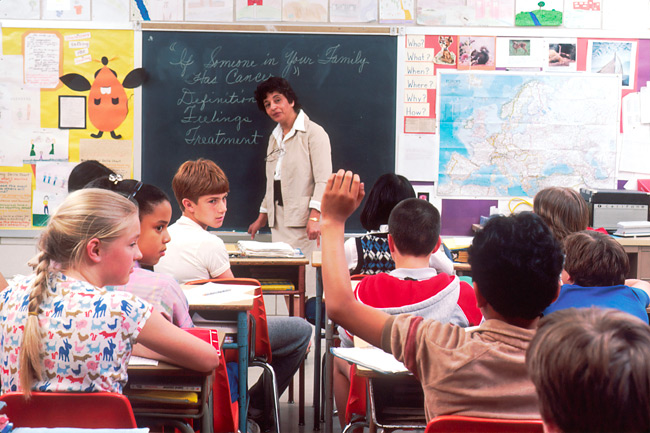
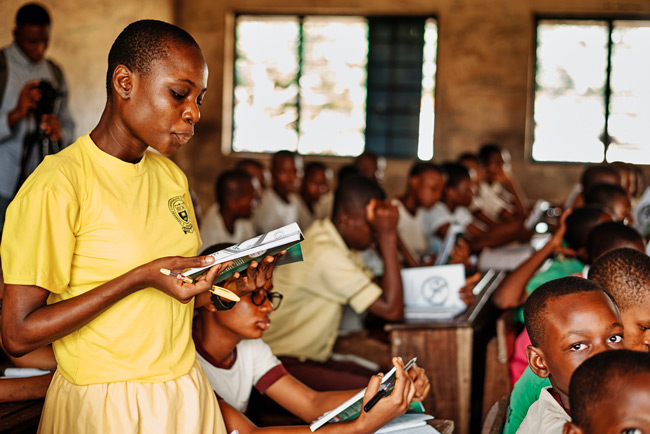
Secondary education: the education program starts to become more subject-oriented. Students can sometimes choose from a variety of options, to start specializing. Students typically have to validate these years with a high school diploma, which is a big milestone that allows them to advance to post-secondary education.
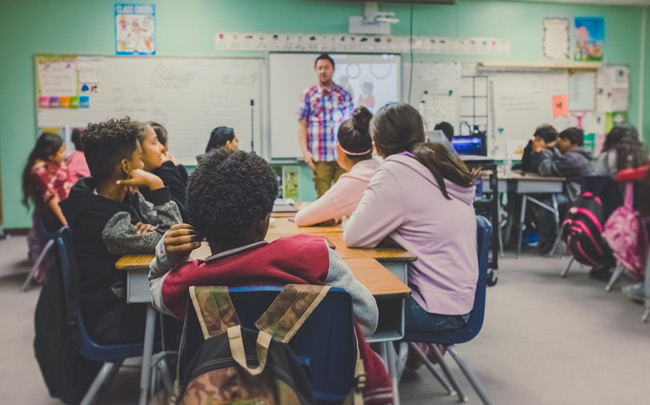
Post-secondary education (or higher education): students are more specialized and prepare to enter the labor market. There are usually several steps and degrees (we’ll get back to them later in the course):
Associate's degree: the first level of qualification, which takes 2 years to complete.
Bachelor’s degree: a more advanced qualification on a speciality, which takes 3 to 4 years to complete.
Master’s degree: a more advanced qualification, usually on a more specific topic than the Bachelor’s degree.
Doctorate (PhD): the student conducts advanced research on a very specific topic. It should lead to the generation of new knowledge.
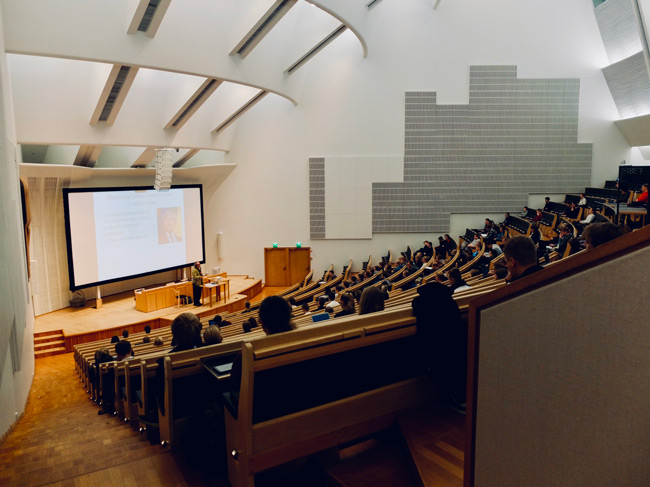
🇺🇳 Country by Country
Now that we’ve seen how education is divided in general, let’s dive in the country specifics. Throughout this course, we’ll focus on 3 countries:
🇺🇸 USA
🇬🇧 UK
🇫🇷 France
We have chosen these 3 countries because they are OpenClassrooms’s main markets. This course might be completed later with information about other countries.
🇺🇸 Formal Education Structure in the USA
If you want to know more about the structure of education in the US, here’s a nice diagram of primary to post-secondary education from the US Department of Education (don’t freak out!):
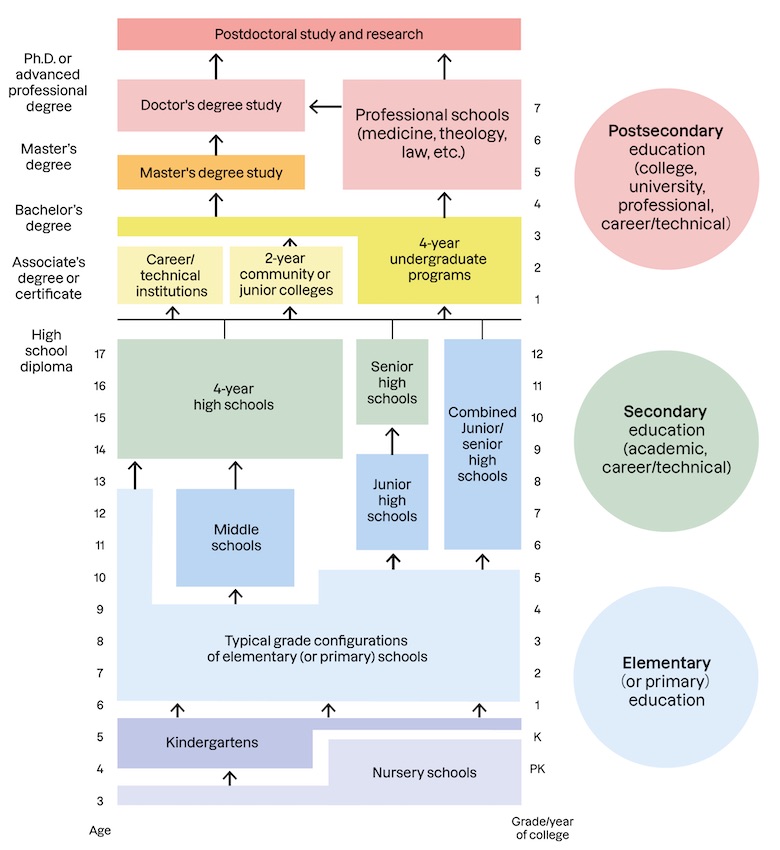
🇬🇧 Formal Education Structure in the UK
In the UK, the education system (from primary to post-secondary) goes like this:
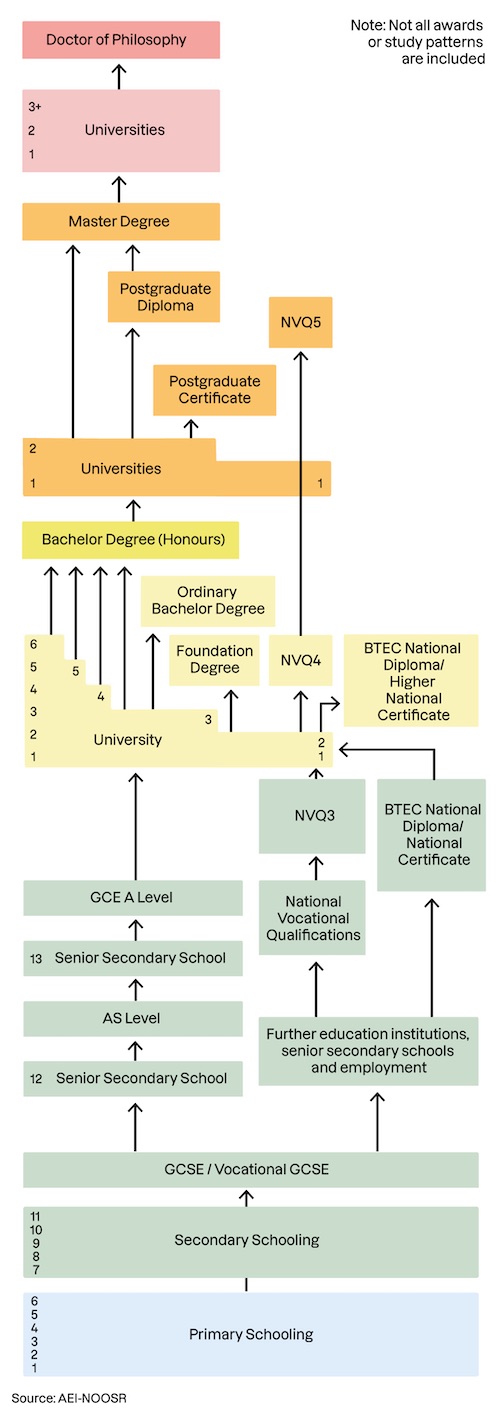
🇫🇷 Formal Education Structure in France
In France, the structure is a bit different but the phases are more or less the same: “école maternelle and école primaire” are primary education, “collège” and “lycée” are secondary education, and then you have “universités” (colleges) and “grandes écoles” (a specific French type of school) for post-secondary education.
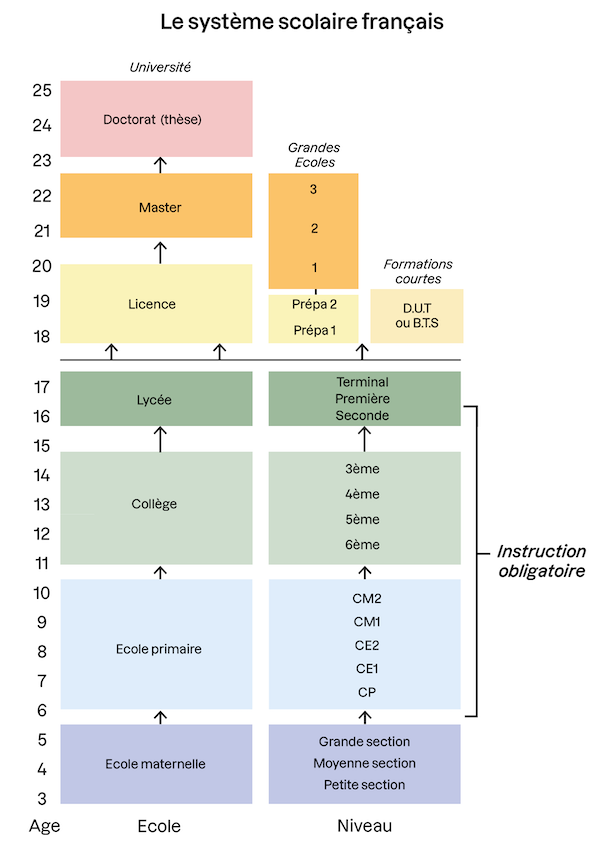
Public and Private Education
Before we go any further, we need to make the distinction between public and private education:
Public education: an education system that is provided by a public body like the State. It is generally funded by public taxes, but there can be tuition fees as well. When you go to a public school, it’s generally free of charge or at low cost for local students.
Private education: an education system that is provided by an individual or an organization (not by the State). It is quite often funded by student tuition fees, but it may also receive money from the State or other organizations. Most often you have to pay to attend private schools, although some of them are free.
I could also mention home schooling, in which students are taught at home (usually by their parents). In this case, they don’t go to school, but will still have to pass exams.
Let me clarify one thing. Not everything is black and white! Public education isn’t always 100% free (you may have to pay for it), while private education can sometimes be funded in part by taxes (depending on the country) and even be entirely free. It is true though that, in general, public education is considered more accessible than private education.
Now that you understand this concept, let’s look at the different education phases again:
Primary and secondary schools (K-12) are generally free in many countries. They are part of the public education system. However, some people can also choose to send their kids to private schools (as early as in primary schools), if they can afford it because it can be quite expensive.
Post-secondary education can be free in some cases, but this is when you usually have to start to pay for education – and it can become very expensive.
🇺🇳 Country by Country
All the fees below are averages, as they can vary widely from one school to another. Note that these fees are per year, so if you plan to study for 5 years, you would have to multiply these numbers by 5 at least. Fees tend to become a bit more expensive as you advance in your education, because you need more specialized teachers.
🇺🇸 USA:
K-12 is free. Private schools for K-12 are available. According to EducationData.org:
Private elementary schools cost $7,630 per year (on average)
Private secondary schools cost $16,040 per year (on average)
For post-secondary education, the average price is $10,000 per year for public colleges and $38,000 per year on average for private colleges (according to USNews). Some elite institutions (Yale, Harvard...) can charge more: $50,000 and above.
🇬🇧 UK:
K-12 is free. Private K-12 schools are available and will cost £13,700 per year on average (The Guardian).
Higher education can cost up to £9,250 per year for UK nationals, and between £10,000 and £38,000 per year for international students (TopUniversities).
🇫🇷 France:
K-12 is free. Private K-12 schools also exist, with fees ranging from 390€ to 1100€ per year. The most expensive K-12 private schools are international private schools that offer bilingual training (French and English). They are much more expensive: they can cost more than 10,000€ per year.
Public higher education costs a few hundred euros per year (170€ to 600€ per year) at university. Some public schools (”école d’ingénieurs”) will cost more than 1000€ per year. Private higher education will typically cost between 5000€ and 10000€ per year.
Continuing Education
Now, let’s dive into professional training (also known as “lifelong learning”). We can distinguish 3 different types of professional training: upskilling, reskilling and apprenticeships.
Upskilling
You learn new skills to get better at your current job. Upskilling can be as little as 3-4 hours of training to 20-40 hours (3-4 days), and sometimes more. All active employees are supposed to do at least some upskilling frequently.
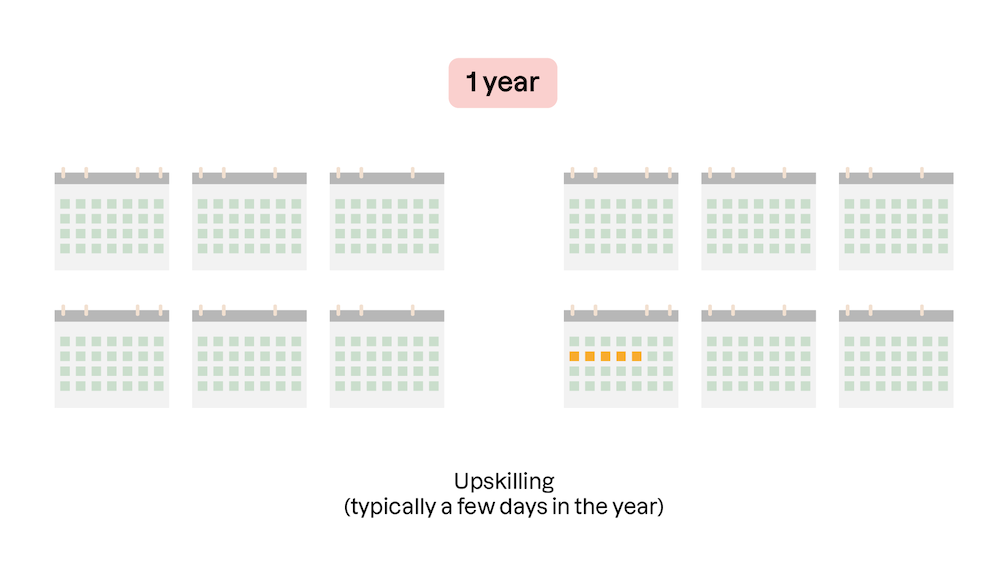
When people talk about professional training, they usually refer to upskilling. It happens usually in relatively small groups of less than 20 people.
It is common to train in things like leadership, stress management, time management, English (as a second language). Training can also be extremely specialized, for instance to learn how to use a specific machine.
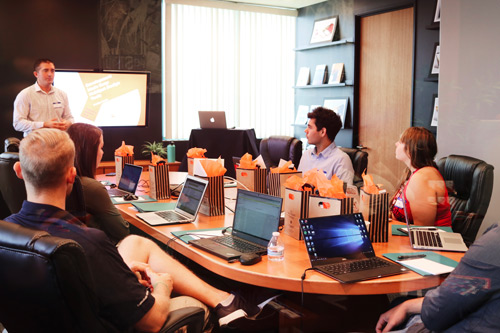
Reskilling
You want to change jobs, because you want to have another career. While this wasn’t common in the past, people are now more likely to want to change careers a few times during their professional life. It can happen because they want to do something else, or because their job has become obsolete due to technology. Training is considered reskilling when it is at least 100-300 hours long, but it can be more (700-1000 hours). In practice, this translates to a few months, up to 1-2 years of training.
People who are reskilling are working adults or in-between jobs, who may have kids or dependants to take care of. They can learn full-time or part-time during evenings and week-ends if they already have a job.
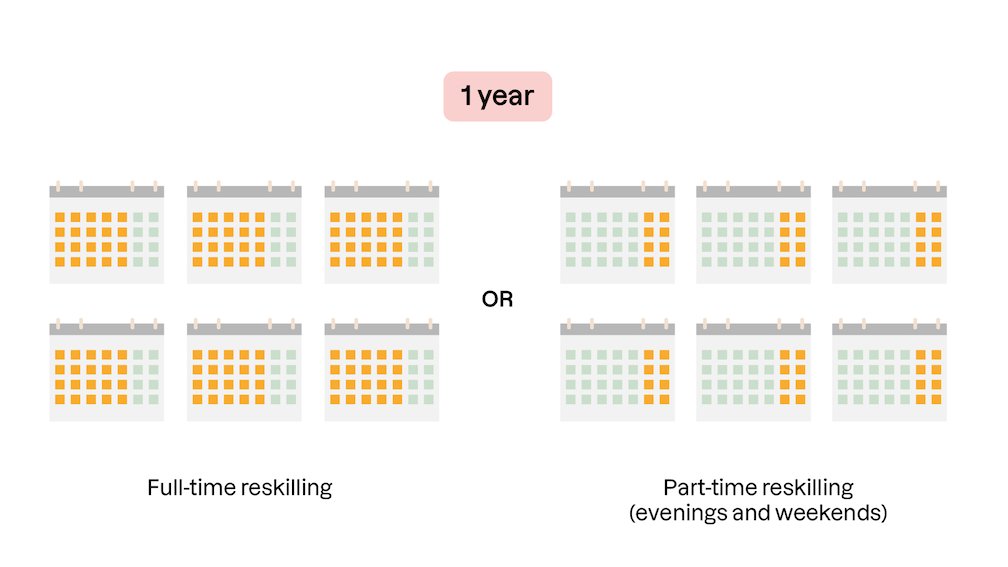
They can go back to college, or to a specific “extension school” designed for them, like Harvard extension school.
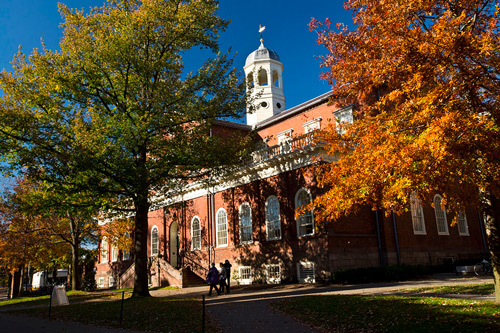
Apprenticeships
You can see apprenticeships as a special form of reskilling. While reskilling can be a full-time experience or a part-time experience during evenings and week-ends, apprenticeships are a part-time experience on specific days of the week. You typically work 3-4 days a week and learn 1-2 days a week. We sometimes refer to it as “work-study”.
What’s special about apprenticeships is that you start your new target job from day 1 of training, even if you don’t have all the skills yet (because you learn on the job). It is different from reskilling where you had to look for a job at the end of your training.
Interestingly, your training fees are fully covered by the company or through existing taxes. Even better, you get a first salary from day 1 too: you can earn roughly $1000-3500 per month.
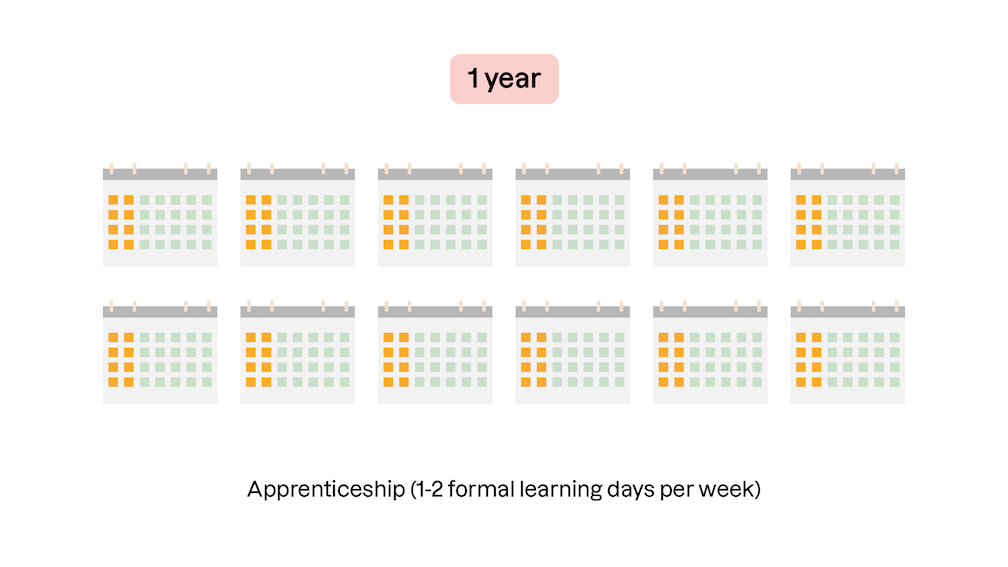
This should give you a good idea of the different types of training for working adults! Of course, this is a bit simplified, but it should be enough to start with.
In the next chapter, we’ll talk about the different learning methodologies: in-person, online, hybrid... knowledge-based, skill-based... There are so many things to learn! See you there! 😃
